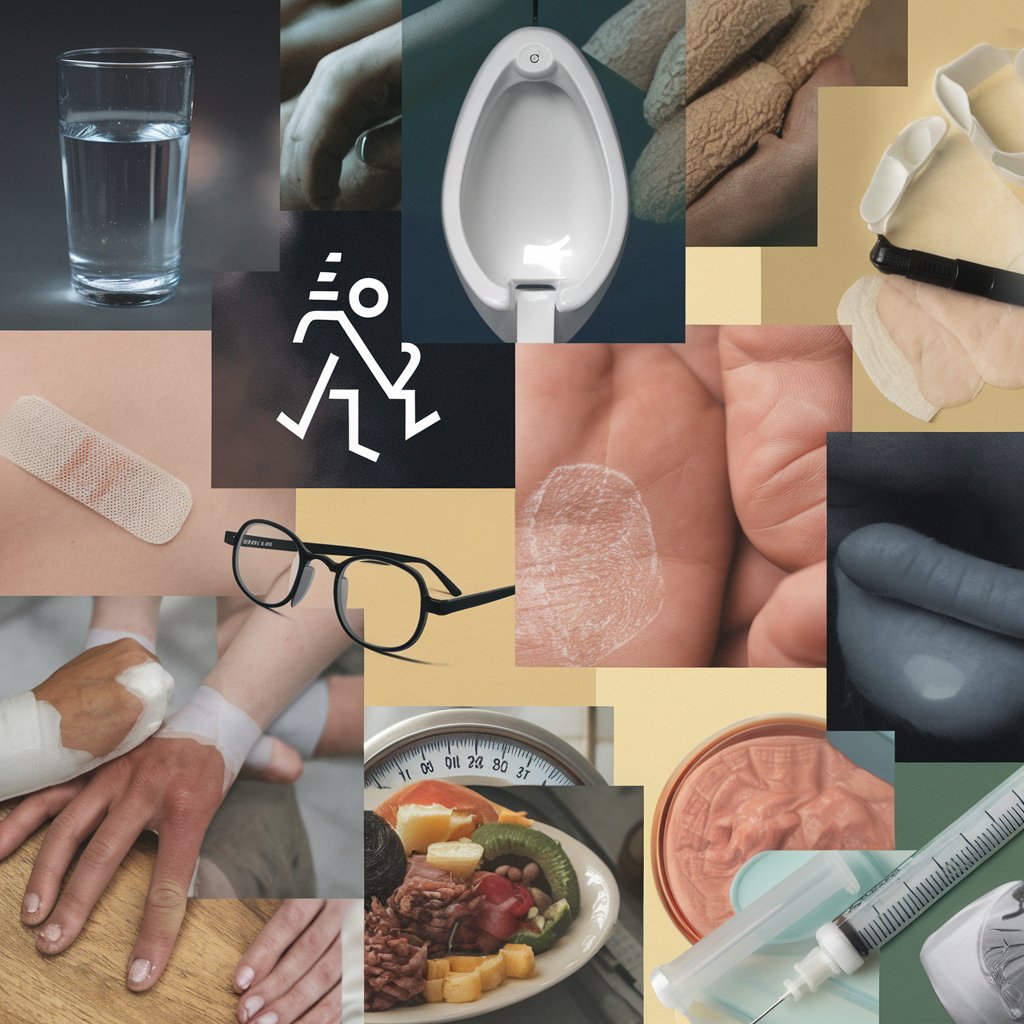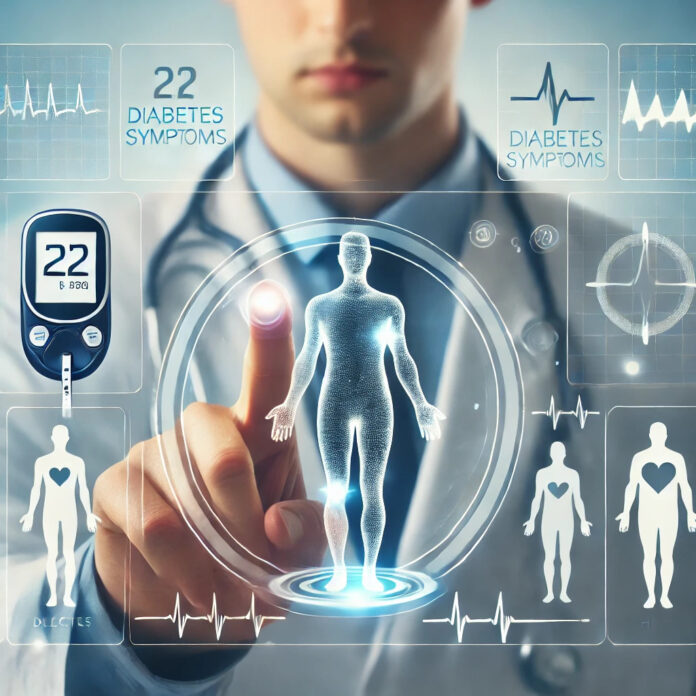Diabetes is a complex health condition that affects millions worldwide. Some symptoms are obvious, but there are subtle signs that often go unnoticed. Growing awareness of diabetes is key to spotting these signs early. This article will help you recognize 12 silent symptoms of diabetes, so you can take care of your health.
Key Takeaways
- Diabetes can exhibit a range of subtle, “silent” symptoms that often go undetected.
- Early recognition of these silent signs is crucial for timely diagnosis and effective treatment.
- Understanding the underlying causes and impact of silent diabetes symptoms can help individuals seek medical attention promptly.
- Increased thirst, frequent urination, unexplained weight loss, and persistent fatigue are some common silent diabetes symptoms.
- Paying attention to skin changes, eye problems, and nerve-related issues can also aid in the early detection of diabetes.
Understanding Silent Diabetes Symptoms and Their Impact
Diabetes is a chronic condition that affects millions globally. It can show up in different ways. Some symptoms of type 1 diabetes and type 2 diabetes are easy to spot. But others are not, leading to late diagnosis and complications.
It’s key to know the silent symptoms of diabetes for early detection and managing this disease well.
The Science Behind Diabetes Development
Diabetes happens when the body can’t control blood sugar levels. In type 1 diabetes, the immune system attacks and destroys insulin-making cells in the pancreas. This means no insulin is made.
In type 2 diabetes, the body doesn’t respond well to insulin. This makes it hard to use the insulin available.
These changes happen slowly. At first, the body tries to balance it out. So, people might not notice symptoms right away.
Why Early Detection Matters
Finding diabetes early is very important. It lets doctors act fast and prevent serious problems. High blood sugar can damage nerves, kidneys, heart, and eyes.
By spotting the silent symptoms of diabetes early and getting medical help, people can manage their condition better. This helps keep their health in top shape.

“Recognizing the silent symptoms of diabetes and seeking prompt medical attention can make all the difference in managing this complex condition.”
Increased Thirst and Frequent Urination
Increased thirst and frequent urination are common symptoms of diabetes. They are seen in both type 2 diabetes symptoms and type 1. These signs often appear together and can signal the start of the disease.
High blood sugar makes the kidneys work hard. They try to remove extra glucose from the blood. This process takes water from the body, causing thirst and the need to urinate more. People with diabetes may drink and go to the bathroom a lot, even at night.
- Excessive thirst, even after drinking fluids
- Urinating more often, especially at night
- Increased volume of urine produced
It’s important to notice these symptoms and see a doctor. Early action can help manage diabetes and prevent serious problems. It can also improve your health.
“Recognizing the signs of increased thirst and frequent urination is a vital first step in identifying and managing diabetes.”
Unexplained Weight Loss Despite Normal Eating
One of the confusing signs of diabetes is losing weight without changing how much you eat. This happens because of changes in how your body uses energy.
Metabolic Changes That Cause Weight Loss
Diabetes makes it hard for your body to use insulin well. Insulin helps control blood sugar levels. Without it, your body can’t use glucose for energy.
So, your body starts breaking down fat and muscle for energy. This leads to losing weight without trying.
Also, diabetes can cause your body to go into ketosis. In ketosis, your body burns fat for energy. This means you lose weight even if you’re eating the same amount.
When Weight Loss Becomes Concerning
Some weight loss is okay when managing what are symptoms of diabetes. But losing a lot of weight quickly is a warning sign. It’s especially true for those with type 1 diabetes symptoms.
Weight loss that happens fast, along with feeling tired, thirsty, and needing to pee a lot, is a red flag. It might mean you need to see a doctor right away.
Keep an eye on any weight changes and talk to your doctor. They can help you stay healthy and avoid bigger problems.
“Unexplained weight loss is a concerning symptom that should not be ignored, as it can be a sign of more serious underlying health issues related to diabetes.”
Persistent Fatigue and Weakness
Persistent fatigue and weakness are common but often overlooked diabetes symptoms. They can greatly affect daily life and productivity. It’s important to understand and recognize these symptoms to manage diabetes well.
Fluctuating blood sugar levels and insulin resistance cause constant tiredness and lack of energy. When the body can’t regulate blood glucose, it leads to energy spikes and crashes. This makes people feel drained and tired.
This symptom can make everyday tasks hard and affect mood and focus. It can lead to mood swings, irritability, and trouble concentrating. These issues make managing diabetes even more challenging.
“Dealing with the constant fatigue is one of the most frustrating aspects of my diabetes. It’s a daily battle to find the energy to get through the day, but I’m learning to manage it with the help of my healthcare team.”
It’s key to recognize and manage persistent fatigue and weakness early. Working with healthcare professionals to control blood sugar and make lifestyle changes can help. This way, individuals can regain their energy and improve their well-being.
| Symptom | Description | Potential Causes |
|---|---|---|
| Persistent Fatigue and Weakness | Constant feeling of tiredness, lack of energy, and difficulty performing daily tasks | Fluctuating blood sugar levels, insulin resistance, metabolic changes |
Diabetes Symptoms That Often Go Unnoticed
Many people don’t know about the silent symptoms of diabetes. These signs are not always obvious. It’s important to recognize them early to manage what is symptoms for diabetes well.
Common Misconceptions About Symptoms
Some think diabetes symptoms are always clear. But, many people with diabetes don’t show the usual signs like thirst or needing to pee a lot at first.
Some with silent symptoms of diabetes might not know they have it until it’s too late. This can lead to serious problems and make it harder to control the disease.
Risk Factors to Consider
- Family history of diabetes
- Overweight or obesity
- Sedentary lifestyle
- Advancing age
- Certain ethnic backgrounds
If you have these risk factors, watch your health closely. See your doctor often. Catching what is symptoms for diabetes early can help a lot.
Knowing the subtle signs and risk factors for silent symptoms of diabetes helps a lot. Regular health checks and talking to your doctor are key. They help catch diabetes early and manage it well.
Slow-Healing Wounds and Frequent Infections
One of the key signs and symptoms of diabetes is slow-healing wounds and a higher risk of infections. This happens because of the metabolic changes in type 2 diabetes symptoms.
Diabetes makes it hard for the body to fight off infections and heal injuries. High blood sugar damages small blood vessels and nerves. These are key for healing wounds and fighting off germs.
So, people with diabetes might see:
- Cuts, scratches, or sores that take longer to heal
- Frequent skin infections, such as boils, fungal infections, or cellulitis
- Increased risk of complications from minor injuries, like infections or delayed healing
It’s important for people with diabetes to take care of their wounds and prevent infections. They should check their blood sugar often, keep wounds clean, and see a doctor quickly if they notice any signs of infection or slow healing.
“Slow-healing wounds and frequent infections are often the first signs that something is wrong with your diabetes management. Pay close attention to any changes in your body’s ability to heal and fight off illness.”
By noticing these signs and symptoms of diabetes and managing them well, people with diabetes can avoid serious problems. This helps them stay healthy and feel good.
Blurred Vision and Eye Problems
Diabetes can harm your eyes, causing blurred vision and other issues. Both type 1 and type 2 diabetes can lead to these problems. So, it’s key to get regular eye exams if you have diabetes.
How Diabetes Affects Eye Health
High blood sugar can damage the tiny blood vessels in your eyes, known as diabetic retinopathy. This damage can make blood vessels leak, swell, or even close. It can lead to vision loss or blindness. Diabetes also raises the risk of cataracts and glaucoma.
Warning Signs of Diabetic Retinopathy
- Blurred or fluctuating vision
- Difficulty seeing at night
- Floaters or dark spots in the field of vision
- Sudden loss of vision
- Distorted or double vision
People with diabetes should get regular eye exams. Early treatment of diabetic retinopathy can prevent vision loss. By catching problems early, you can manage your diabetes better and keep your eyes healthy.
| Symptom | Description |
|---|---|
| Blurred Vision | High blood sugar levels can cause the lens of the eye to swell, leading to blurred or cloudy vision. |
| Floaters | Small specks or “floaters” in the field of vision, caused by changes in the vitreous (gel-like substance in the eye). |
| Difficulty Adapting to Darkness | Diabetes can affect the retina’s ability to adapt to changes in light, making it harder to see in low-light conditions. |
| Double Vision | Diabetes can cause the muscles that control eye movement to become weaker, leading to double vision. |
Understanding how diabetes affects your eyes and knowing the signs of diabetic retinopathy is crucial. If you have diabetes symptoms, whether type 1 diabetes or type 2 diabetes, you can protect your vision and eye health.
Numbness or Tingling in Hands and Feet
Feeling numb or tingly in your hands and feet is a common sign of diabetes. This is called diabetic neuropathy. It happens when high blood sugar damages nerves, making it hard for them to send signals.
If you notice numbness or tingling in your hands and feet, see a doctor. These signs can mean serious nerve damage if left untreated. It’s important to know if you have diabetes.
Understanding Diabetic Neuropathy
Diabetic neuropathy starts with numbness in the toes and feet. It can spread up the legs and sometimes to the hands and arms. Early signs include tingling or burning. Later, you might lose all feeling and risk falling or getting hurt.
- Caused by high blood sugar levels damaging the nerves over time
- Often the first sign that an individual may have undiagnosed diabetes
- Can lead to foot ulcers, infections, and even amputation if left untreated
Importance of Early Detection and Management
Spotting diabetic neuropathy early is key. Early treatment can stop it from getting worse. Working with a doctor and making healthy lifestyle choices can help avoid nerve damage.
| Symptom | Potential Cause | Recommended Action |
|---|---|---|
| Numbness or tingling in hands and feet | Diabetic neuropathy | Consult a healthcare provider, monitor blood sugar levels, and implement lifestyle changes to manage diabetes |
If you have numbness or tingling in your hands and feet, don’t ignore it. See a doctor right away to prevent nerve damage.
Skin Changes and Dark Patches
Diabetes can show itself through skin changes, often seen as just skin issues. But, these signs can really mean something serious. A key sign is acanthosis nigricans, which causes dark, velvety patches on the skin.
Understanding Diabetic Skin Conditions
Acanthosis nigricans is a common skin problem linked to diabetes. It makes the skin thick and dark, usually on the neck, armpits, elbows, or knees. It’s a sign of insulin resistance, a sign of type 2 diabetes coming.
Diabetes can also cause other skin problems. For example, necrobiosis lipoidica diabeticorum (NLD) makes the skin look reddish-brown and shiny. Also, fungal infections can grow in the moist skin caused by high blood sugar.
When to Seek Medical Attention
If you see any strange skin changes, tell your doctor right away. These signs might mean you have diabetes or it’s getting worse. Getting checked out early can help catch and treat problems before they get worse.
Don’t wait to see a doctor if you notice symptoms of diabetes that worry you.
“Paying attention to subtle skin changes can be the key to uncovering underlying health issues, including diabetes.”
Increased Hunger and Changes in Appetite
One of the lesser-known symptoms of type 2 diabetes is a persistent increase in hunger, known as polyphagia. This can be puzzling and often overlooked. The body’s inability to use insulin well can lead to big changes in appetite and food cravings.
Insulin resistance, a hallmark of type 2 diabetes, disrupts blood sugar regulation. When cells can’t use glucose well, the brain may think it needs more fuel. This can trigger a constant feeling of hunger. Despite eating more, people with type 2 diabetes symptoms may still lose weight unexpectedly. This is because their body struggles to use and distribute energy properly.
This mix of increased appetite and unexpected weight loss is a key early sign of what is symptoms for diabetes. Noticing these changes in hunger and appetite can help people get medical help early. It’s a step towards managing their condition.
“Paying attention to changes in your hunger and appetite can be a valuable clue in identifying potential diabetes symptoms, even before other more obvious signs appear.”
Understanding polyphagia and its link to type 2 diabetes helps people recognize this symptom. Watching for changes in appetite is a key first step. It’s important for seeking medical care and preventing the condition from getting worse.
Mood Changes and Irritability
Diabetes can deeply affect a person’s mood, causing changes and irritability. This symptom of diabetes can really impact someone’s life and how well they manage their condition.
The link between diabetes symptoms and mood is complex. Blood sugar changes can lead to mood swings, causing irritability, anxiety, and even depression. The brain needs a steady glucose supply to work right, and blood sugar changes can mess with brain chemistry.
Managing diabetes daily can also stress people out. It involves constant blood sugar checks, insulin shots, and strict diets. This can be very hard, leading to frustration, stress, and burnout.
It’s key for people with diabetes to take care of their emotional health too. Seeing a therapist or counselor regularly can help. They can teach coping skills and offer support when needed.
By focusing on their emotional health, people with diabetes can manage their condition better. This can improve their life quality and lower the risk of serious mental health problems. Recognizing and dealing with silent symptoms of diabetes like mood changes is crucial for good health.
| Emotional Impact of Diabetes | Strategies for Managing Emotional Well-being |
|---|---|
| Mood swings Irritability Anxiety Depression | Regular check-ins with a mental health professional Developing coping strategies for stress management Engaging in regular physical activity Practicing mindfulness and relaxation techniques |
“Addressing the emotional impact of diabetes is just as important as managing the physical symptoms. By taking a holistic approach, individuals can improve their overall well-being and better navigate the challenges of this chronic condition.”
Conclusion
This article has highlighted 12 silent symptoms of diabetes that are often missed. These include increased thirst, frequent urination, and unexplained weight loss. Other signs are persistent fatigue, skin changes, and more.
These symptoms can be overlooked, which can delay early detection and treatment. It’s important to understand the causes and recognize these signs. Early detection of diabetes can greatly improve health outcomes and prevent serious problems.
Regular health check-ups and talking to a doctor are key. They can spot the signs and symptoms of diabetes and start the right treatment. By being proactive about your health, you can manage your condition better and stay well.
Diabetes is a complex condition, but with the right knowledge and self-care, you can control your health. Stay alert, listen to your body, and seek medical advice if you notice any of these symptoms.
FAQ
What are the symptoms of diabetes?
Symptoms of diabetes include feeling very thirsty and needing to pee a lot. You might also lose weight without trying, feel tired all the time, and have slow-healing wounds. Other signs are blurred vision, numbness in your hands and feet, and changes in your skin. You might also feel hungrier than usual and have mood swings.
How do I know if I have diabetes?
If you’re feeling very thirsty, peeing a lot, or losing weight without trying, see a doctor. They can do tests to see if you have diabetes.
What are the differences between type 1 and type 2 diabetes symptoms?
Type 1 diabetes symptoms come on fast and can include losing weight quickly. Type 2 diabetes symptoms start slower and might include feeling thirsty, tired, and having slow-healing wounds.
What are the silent symptoms of diabetes?
Silent symptoms of diabetes include mood swings, skin changes, and numbness in your hands and feet. These symptoms are easy to miss, so it’s important to know them.
How do you get diabetes?
Diabetes comes from a mix of genetics and lifestyle. Type 1 diabetes is when your body attacks insulin-making cells. Type 2 diabetes is linked to being overweight, eating poorly, and not being active enough.
What are the signs and symptoms of diabetes that I should be aware of?
Look out for signs like feeling very thirsty and needing to pee a lot. Also, watch for unexplained weight loss, feeling tired, and wounds that won’t heal. Other signs are blurred vision, numbness in your hands and feet, skin changes, feeling hungrier than usual, and mood swings. If you notice any of these, see a doctor right away.



























